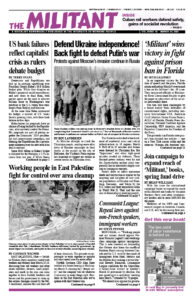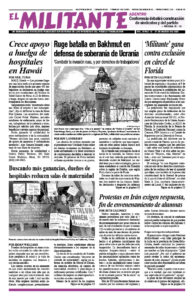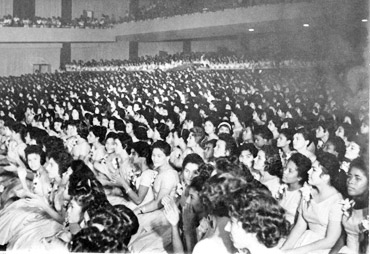To mark International Women’s Day, one of Pathfinder’s Books of the Month for March is Women in Cuba: The Making of a Revolution Within the Revolution. It is by three leaders of the Federation of Cuban Women, Vilma Espín, Asela de los Santos and Yolanda Ferrer. This extract is from the chapter, “With No Preconceived Structure or Agenda.” It tells the story of how Cuban women — workers, peasants, housewives and youth — demanded to be part of the unfolding socialist revolution and how doing so transformed their lives. Copyright © 2012 by Pathfinder Press. Reprinted by permission.
The Federation of Cuban Women was launched on August 23, 1960. In reality, however, we had been laying the foundations for more than a year.
In 1959, the first year after the triumph, women wanted to organize to participate more effectively in the tasks of the revolution, and we responded to this pressure. I remember being struck, in the first months after the January 1 victory, by the large number of women, some carrying babies, who took part in demonstrations and street actions. There was strong support for the revolution, even before it had demonstrated its full meaning.
Women who were already organized in various small groups approached me. They wrote letters; they asked to meet. These included people from the women’s sections of the political parties that supported the revolution. Others came from religious organizations, such as groups of Catholic and Baptist women. There were trade union members — from the garment union, for example. There were peasant women. And, of course, there were women who had taken part in the war.
As you might expect, those of us who had participated in the war — whether in the urban underground or in the mountains — were approached by women who wanted to do precisely what we had done, to take part in the revolution. They looked to us for leadership.
“What can we do?” they asked.
“How can we show our support for the revolution?” “What’s needed most?”
They asked to be trained in emergency medical care, because of the threats and attacks from imperialism. So that became one of our first tasks, even before we organized the Federation of Cuban Women. It was these classes, in fact, along with the sewing classes we organized, that gave birth to the federation — not the other way around.
The classes weren’t just a way of responding to women who had asked for emergency medical training. They were a way of bringing women together, so we could discuss things they wanted to know about the revolution.
Then the first revolutionary laws started to be issued by the new government.
From the very beginning we decided that all children would go to school. Parents were required by law to make sure they did so. So the first big job was to find enough teachers. Women responded to this need, both those who were already teachers and those who had finished sixth grade and were taking review courses to prepare for teaching.
Many women who were housewives, who didn’t work outside the home, who had devoted themselves only to their children and their families, reached out to us. They, too, asked us what they could do.
We began to organize women who were already in trade unions, women who were workers, and women who had some kind of political experience, either in the past or more recently. We helped them set up classes in emergency medical treatment and sewing. The medical care classes were taught with the help of the Armed Forces and the Red Cross. The sewing classes were taught by women who had completed the initial courses. This was a way of organizing women who were housewives. They were very eager to learn how to make clothes for themselves and their children.
Women in the classes who had some political experience explained the new laws to others. When the Agrarian Reform Law was adopted, women asked a lot of questions about it. Peasant women, of course, had a better understanding of what the law meant. But many women approached others known for their activity during the revolutionary struggle to learn about it and how they could support the revolution.
So the federation arose not so much as a decision of the revolutionary leadership but as a response to the demand from masses of women from different layers of society who were already in action. …
When I talk about how the federation was created, I always emphasize that at the time we didn’t talk about women’s liberation. We didn’t talk about women’s emancipation, or the struggle for equality. We didn’t use those terms then. What we did talk about was participation. Women wanted to participate. This included women who had taken an active part in the struggle, who had been in the mountains. They, like other women across the country, wanted to help in this new stage that was dawning, which was a genuine revolution.
From the very beginning, the new laws made it clear to the mother, the housewife, the woman who had lost her children in the struggle, that this revolution was in her interests. It was in the interests of her children and her family.
Women had confidence in the revolution — because there was real proof, every day, that the revolution wasn’t just hot air, it wasn’t empty phrases of the kind people were used to hearing from politicians in the past. This was the genuine thing. And women wanted to be part of it, to do something. The more the revolutionary laws strengthened this conviction, the more women demanded a chance to contribute — and the more they saw how necessary their contribution was.
Sometimes I’m asked to give a one-word definition of the Cuban Revolution. I reply that it’s about participation — the participation of the entire people in everything. Together, the population went through difficult years. For women, this had an impact right from the beginning. They began to understand the point Lenin emphasized over and over — that for a revolution to move forward, to develop, women had to participate.


